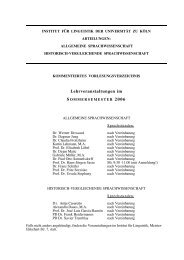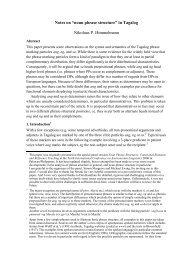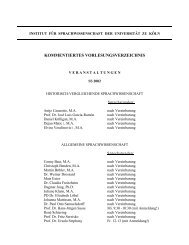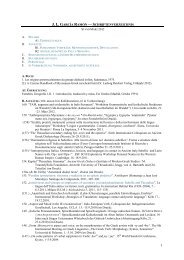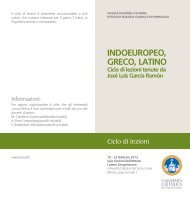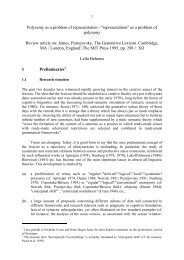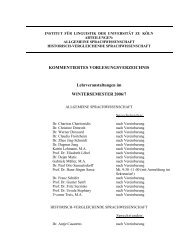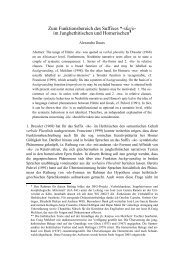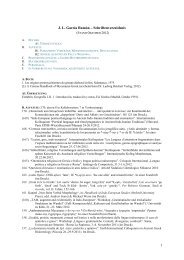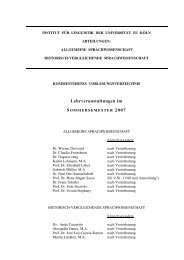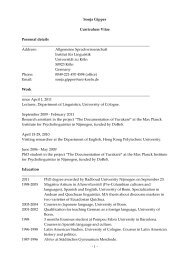Topics in Anatolian Historical Grammar Prof. Dr. H. Craig Melchert
Topics in Anatolian Historical Grammar Prof. Dr. H. Craig Melchert
Topics in Anatolian Historical Grammar Prof. Dr. H. Craig Melchert
You also want an ePaper? Increase the reach of your titles
YUMPU automatically turns print PDFs into web optimized ePapers that Google loves.
3<br />
As to Grk. γέγωνε ‘shouts’, compell<strong>in</strong>g comparison with TochA ken- ‘call’ po<strong>in</strong>ts decisively to<br />
an atelic root: “Beide teilen die Eigenschaft der Defektivität und bilden nur imperfektive<br />
Stämme: im Osttocharischen den Präsensstamm, im Griechischen den Perfektstamm; perfektive<br />
Stämme fehlen” (Hackste<strong>in</strong> 2002: 188). For differ<strong>in</strong>g attempts to account for long vowel <strong>in</strong> root<br />
compare Hackste<strong>in</strong> (2002: 189-91) and V<strong>in</strong>e (2007: 352-4).<br />
Evidence for orig<strong>in</strong>al telic sense of Skt. kan- ‘rejoice’ (Kümmel 2000: 130-33, LIV 2 : 352) and<br />
jav i - ‘hasten’ (Kümmel 2000: 198-9, LIV 2 : 166) is also very weak (see Di Giov<strong>in</strong>e 1990: 281 on<br />
the latter).<br />
3. Case of *leloígh- ‘licks’ more dubious: based on supposed equation of respectively isolated<br />
Vedic ririhvāṃsaṃ ‘the lick<strong>in</strong>g one’ (RV 10,79,3d) and Greek λελιχμότες (for *λελιχϝότες)<br />
‘lick<strong>in</strong>g’ (Hesiod, Theogony 826). Thus LIV 2 : 404, after de Lamberterie (1998: 375-9) and<br />
Kümmel (2000: 429). If correct, contra de Lamberterie (1998: 379) the perfect does not express<br />
“un état du corps”. Rather with Kümmel, loc. cit., one must concede: “Der vom Perfekt<br />
bezeichnete Zustand ist folglich hier auch nicht naktostatisch, sondern eher durch andauernde<br />
Iteration hervorgerufen bzw. habituell, d.h. es handelt sich um e<strong>in</strong> zeitlos-kont<strong>in</strong>uatives<br />
Perfekt.” (emphasis m<strong>in</strong>e—HCM). Note further with Kümmel that this root forms a PIE root<br />
present, has iterative-durative Aktionsart, and the action results <strong>in</strong> no change <strong>in</strong> the state of the<br />
subject. However, de Lamberterie’s analysis of Greek questionable: for alternative <strong>in</strong>ner-Greek<br />
analysis see Hackste<strong>in</strong> 2002: 195-6. Thus ririhvāṃsaṃ may be Vedic creation, merely modeled<br />
on other cases cited.<br />
IV. Compatibility of ‘achieved state’ and ‘iteration’<br />
A. Realization of Aktionsarten dependent on “Verbalcharakter”/lexical semantics: see e.g.<br />
García Ramón (2002).<br />
B. System of Dowty-Vendler (see Dowty 1979) dist<strong>in</strong>guishes states (‘sh<strong>in</strong>e’, ‘be’), activities<br />
(‘weep’, ‘walk’)—from which one should dist<strong>in</strong>guish semelfactives (‘bl<strong>in</strong>k’, ‘hit’)—, accomplishments<br />
(‘pa<strong>in</strong>t’, ‘b<strong>in</strong>d’), and achievements (‘w<strong>in</strong>’, ‘die’). For present purposes the crucial<br />
dist<strong>in</strong>ction is statives and atelics (activities and semelfactives) versus telics (accomplishments<br />
and achievements).<br />
As per Di Giov<strong>in</strong>e (1990), Kümmel (2000: 67), et al., stative verbs (e.g. *bheh 2 - ‘sh<strong>in</strong>e’) did not<br />
form perfects <strong>in</strong> PIE. Verbs form<strong>in</strong>g the perfect had to be processual. However, as noted by Meid<br />
(1983: 330), it cannot be accidental that all well established examples of perfects express<strong>in</strong>g an<br />
atta<strong>in</strong>ed state are <strong>in</strong> fact telic, s<strong>in</strong>ce only telic verbs lead to a result (‘b<strong>in</strong>d’ > ‘hold bound’; ‘die’<br />
> ‘be dead’). However, atelic verbs (‘turn=revolve’; ‘shiver’; ‘hasten’) cannot lead to a result<br />
and an achieved state.<br />
C. Hypothesis 1: the PIE perfect expressed a durative Aktionsart (cf. already <strong>in</strong> nuce Hirt 1928:<br />
280 and Meid 1983: 330). In telic verbs duration could only be realized <strong>in</strong> the state result<strong>in</strong>g<br />
from the action. For atelic verbs the effect was durative or iterative. That reduplication with<br />
*CV- marked duration is not surpris<strong>in</strong>g (pace Di Giov<strong>in</strong>e 1996: 117). Special value of durative<br />
Aktionsart <strong>in</strong> the perfect (vs. varieties of the “present”) surely due to the other def<strong>in</strong><strong>in</strong>g formal<br />
characteristics: o-grade of root and special end<strong>in</strong>gs. For o-grade see Di Giov<strong>in</strong>e (2012).



